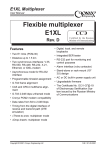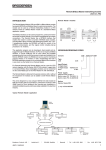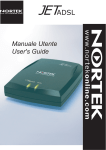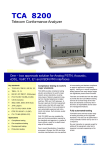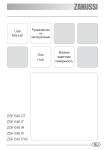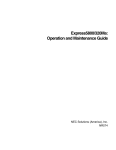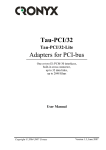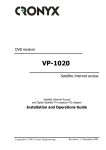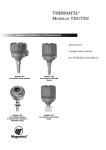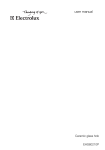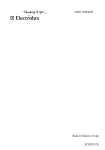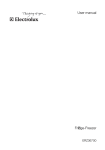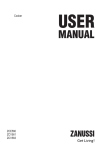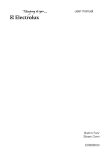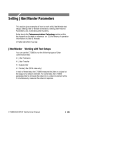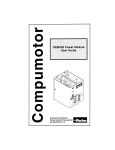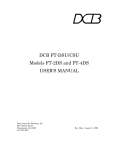Download Modem E1
Transcript
Modem-converter E1-L User‘s Guide 1234567890123456789012345678901212345678901234567890123456789012123456789012345678901234567890121234567 1234567890123456789012345678901212345678901234567890123456789012123456789012345678901234567890121234567 Modem E1 Features Contents • E1 G703/G704 channel Description • Distance up to 1.5 km • V.35/RS-530/RS-449/RS-232/X.21/ Ethernet user data interface • Data rate from 64 kbps up to 2048 kbps • Programmable timeslot assignment • G.703 2048 kbps unframed mode • Cronyx PCM2 compatibility • CAS and CRC4 framing • Synchronization from digital interface (DTE emulation) • Digital, local and remote loopbacks • Integrated BER tester • RS-232 Control port • Dry contacts alarm interface Package Contents Specifications Ordering Code Controls and Indicators Controls on Front Panel Front Panel Indicators DIP Switches Jumpers Line Impedance Transmit Clock Inversion Clock Source Selection Single clock source Separate clock sources Loop Selection Normal Operation Local Loopback Remote Loopback Digital Loopback • Stand-alone or rack-mount (19’’3U) Alarm Interface • AC or DC power Rear Panel Connectors • The certificate No. ÎÑ/1-ÑÏÄ-19 ÑÑÝ of the Russian Ministry of Communications (registration number ÐÎÑÑ RU.0001.01ÝÑ00) Copyright © 1998-2000 Cronyx Engineering Console Cables Wiring 1.0E / 01.12.2000 1 MODEM-CONVERTER E1-L 12345678901234567890123456789012123456789012345678901234567890121234567890123456789012345678901212345678901234567890123456789012123456789 12345678901234567890123456789012123456789012345678901234567890121234567890123456789012345678901212345678901234567890123456789012123456789 Description Cronyx - E1-L is a multipurpose access unit for Fractional E1 services. As a rate and interface converter it accepts digital interface data at any multiple rate of 64 kbps up to 2048 kbps and places it into E1 frame using required number of timeslots or the whole bandwidth of 2048 kbps in unframed mode. As a modem it is capable to operate at distances up to 1.5 km over twisted pair or coaxial cable. E1-L device is available as stand-alone unit or as a card for 19’’ 3U Cronyx rack. Rack mount modem consists of two cards one of which is set on the front side and the other on the back side of the rack. V.35, Ethernet etc. Digital Interface To terminal RS-232 E1 Interface Channel E1 (up to 1.5 km) Control port It can be ordered with RS-530, RS-232, V.35 or X.21 interfaces, ended with standard connectors. Multi-standard interface option with HDB44 connector is also available. The type of interface in this case is determined by adapter cable: RS-232, RS530, RS-449, RS-442, V.35 or X.21. V.35 / RS-530 / RS-232 64...2048 kbps Router 2 E1-L Device can be ordered with Ethernet interface. A couple of devices with this interface form a remote bridge for two LANs. Configuration can be performed via RS232 control port or by DIP switches. Configuration parameters are stored in NVRAM. Maintenance capabilities include user activated local and remote loopbacks on the E1 link. In-band management of the remote unit can be performed by using the spare bits (Sa) on timeslot 0 (in compliance with G.704 recommendation). Modem E1-L is also available as a card for Intel-compatible computers (Cronyx-Tau/ E1, Cronyx Tau-PCI/E1). Package Contents The following is a check list for the contents of your package: • Modem E1-L in ordered configuration • Removable terminal block for E1 line • Power supply cord (for AC power models) • User manual Network Е1 E1-L Copyright © 1998-2000 Cronyx Engineering MODEM-CONVERTER E1-L 12345678901234567890123456789012123456789012345678901234567890121234567890123456789012345678901212345678901234567890123456789012123456789 12345678901234567890123456789012123456789012345678901234567890121234567890123456789012345678901212345678901234567890123456789012123456789 Specifications Digital Interface Data Transfer Rate.............................. N x 64 kbps or up to 2048 kbps in unframed mode Clock Options .................................... TXC, RXC, ETC, ERC ModemControl Signals ...................... DTR, DSR, CTS, RTS, CD E1 Interface Line Coding ....................................... HDB3 Line Impedance .................................. 120 Ohm Balanced (Twisted Pair) or 75 Ohm Unbalanced (Coax Cable) Input Signal Attenuation Range ......... from 0 to –30 dB, up to 1.5 km of 22 AWG (0.6 mm) twisted pair Transmit Timing Sources ................... INT (Internal Oscillator) RCV (Receiver) EXT (Digital Interface) Jitter Attenuator .................................. Both in receive & transmit path, 120 UIpp attenuation Frame structure .................................. G.704 or unframed mode Multiframes ........................................ CRC4, CAS(G.704) Frequencies offset Adjustment ........... Controlled Slip Buffer Connector Type .................................. Terminal Block Alarm Interface Relay Contact Current ........................ up to 250mA Relay Contact Voltage ........................ up to 175V DC Control Port Interface ............................................. RS-232 Protocol .............................................. Async 19200 bps, 8 bit/char , 1 stop bit, no parity Connector Type .................................. DB9 Diagnostics Loopbacks .......................................... Digital, local (G.703 line on local unit), remote (G.703 line on remote unit), selected by front panel switches or via control port BER Tester.......................................... Activated by front panel switch or via control port Copyright © 1998-2000 Cronyx Engineering 3 MODEM-CONVERTER E1-L 12345678901234567890123456789012123456789012345678901234567890121234567890123456789012345678901212345678901234567890123456789012123456789 12345678901234567890123456789012123456789012345678901234567890121234567890123456789012345678901212345678901234567890123456789012123456789 Ordering Code E1-L / B-M-AC Power supply: AC – ~220V, DC – =60V (for stand-alone unit only) Digital interface: M – multistandard V35 – V.35 232 – RS-232 530 – RS-530 ETH – Ethernet Construction: B – stand-alone unit R – Rack mount card Model: E1-L – modem E1 Controls and Indicators Controls on front panel BERT – bit error rate tester switch: BERT BER tester switch ON E1 line testing OFF normal operation LOOP – two loopback mode switches: Loopback LOOP1 LOOP2 Disable OFF Any Local loop on link E1 ON LOC Remote loop on link E1 ON REM Digital loop ON DIG Front panel indicators Indicator Description PWR Power supply RTS Digital interface signal (Ready to Send) 4 RERR Remote unit errors LERR Local unit errors TST Test modes Copyright © 1998-2000 Cronyx Engineering MODEM-CONVERTER E1-L 12345678901234567890123456789012123456789012345678901234567890121234567890123456789012345678901212345678901234567890123456789012123456789 12345678901234567890123456789012123456789012345678901234567890121234567890123456789012345678901212345678901234567890123456789012123456789 TST indicator: State Description Off Normal operation Lights BER tester is ON Continuous Blinks Local loop is ON Single blinks Remote loop is ON Double blinks Digital loop is ON LERR indicator lights if there is no signal on E1 line, if external clock frequency doesn’t correspond with the selected data transfer rate, if synchronization is lost in framed operation mode. If BER test mode is ON, LERR indicator lights if there are errors in E1 line. RERR indicator lights if synchronization is lost on remote unit (bit A of timeslot 0). RERR indicator is not used in unframed operation mode. S3 Modem configuration & synchronization S1 E1 frame timeslots Bottom cover view Stand-alone unit E1 frame timeslots Modem configuration & synchronization S1 S3 Component side view DIP switches Rack mount card ON 1 2 3 4 5 6 7 8 9 10 DIP switches are placed on bottom cover of stand-alone unit and on component side of card in rack mount unit. S1 group — E1 frame timeslots or data transfer rate on digital port in unframed operation mode. S3 group — Modem configuration & synchronization. Copyright © 1998-2000 Cronyx Engineering The following designations are used for DIP switch state indication: OFF ON 5 MODEM-CONVERTER E1-L 12345678901234567890123456789012123456789012345678901234567890121234567890123456789012345678901212345678901234567890123456789012123456789 12345678901234567890123456789012123456789012345678901234567890121234567890123456789012345678901212345678901234567890123456789012123456789 Configuration Saving S3-9 switch enables remote control of modem: parameters are set by terminal connected to control port or by network via SNMP protocol (rack mount unit). In remote control mode parameters are stored in NVRAM. If remote control is disabled NVRAM is not used and parameters are set only by DIP switches. S3-9 Parameters setting By switches only, remote control is disabled, NVRAM is not used By terminal, parameters are saved in NVRAM, DIP switches are not used Synchronization S3-1, S3-2 switches set E1 channel synchronization mode: S3-1 S3-2 by inverting the transmit clock signal using S3-6 switch: S3-6 TXC inversion no TXC inversion TXC inversion Receive Clock Inversion When DTE2 emulation is used, the RXD signal is delayed in relation to ERC clock. Summary delay is formed by cable delay and digital interfaces delay of modem and connected device. As a result of this delay errors can occur at some data rates. The problem can be solved by ERC inversion via S3-7 switch. When DTE2 emulation is not used, the S37 switch controls RXC inversion in relation to received data RXD: S3-7 RXC or ERC inversion E1 channel synchronization no RXC or ERC inversion INT – internal oscillator RXC or ERC inversion RCV – from receiver DTE1 emulation (ETC) Use of Timeslot 16 / Scrambler DTE2 emulation (ETC, ERC) Transmit Clock Inversion When INT or RCV synchronization mode is used, data signal TXD is delayed in relation to TXC clock. Summary delay is formed by cable delay and digital interfaces delay of modem and connected device. As a result of this delay errors can occur at some data rates. The problem can be solved 6 S3-3 switch controls use of E1 frame timeslot 16 in framed mode. In unframed mode S3-3 switch controls data scrambling. S3-3 Framed mode: Timeslot 16 Unframed mode: Scrambler reserved for signaling disabled enabled for data enabled Copyright © 1998-2000 Cronyx Engineering MODEM-CONVERTER E1-L 12345678901234567890123456789012123456789012345678901234567890121234567890123456789012345678901212345678901234567890123456789012123456789 12345678901234567890123456789012123456789012345678901234567890121234567890123456789012345678901212345678901234567890123456789012123456789 Unframed Mode Selection S3-8 switch controls unframed mode selection. In this mode E1-L modem is compatible with Cronyx PCM2. S3-8 Unframed mode S1-1...S1-5 - initial timeslot of E1 frame timeslot 1 (one, not zero) timeslot 1 timeslot 2 timeslot 3 timeslot 4 timeslot 5 is on timeslot 6 is off timeslot 7 timeslot 8 CTS Signal Control timeslot 9 timeslot 10 CTS signal control mode is selected by S34 and S3-5 switches: timeslot 11 timeslot 12 timeslot 13 S3-4 S3-5 CTS mode timeslot 14 CTS = 1 timeslot 15 CTS = CD timeslot 16 CTS = RTS timeslot 17 CTS = RTS*CD timeslot 18 timeslot 19 timeslot 20 Input Signal Gain timeslot 21 timeslot 22 E1 channel receiver sensitivity can be set to -12 dB or –30 dB level. The S3-10 switch selects receiver sensitivity: S3-10 receiver sensitivity normal (-12 dB) high (-30 dB) timeslot 23 timeslot 24 timeslot 25 timeslot 26 timeslot 27 timeslot 28 timeslot 29 timeslot 30 Initial Timeslot S1-1 ... S1-5 switches select the number of initial timeslot of E1 frame. They do not affect the modem operation in unframed mode. Copyright © 1998-2000 Cronyx Engineering timeslot 31 Number of Timeslots S1-6 ... S1-10 switches select the number of timeslots used for data transmission. Data transfer rate depends on the number of timeslots selected and is equal N x 64 7 MODEM-CONVERTER E1-L 12345678901234567890123456789012123456789012345678901234567890121234567890123456789012345678901212345678901234567890123456789012123456789 12345678901234567890123456789012123456789012345678901234567890121234567890123456789012345678901212345678901234567890123456789012123456789 kbps. In unframed mode the switches select only fixed data transfer rates: 2048, 1024, 512, 128, 64 kbps (marked with * in table). S1-6...S1-10 — number of TS — data rate 0 timeslots — 0 kbps 1 timeslot — 64 kbps 2 timeslots — 128 kbps 3 timeslots — 192 kbps 4 timeslots — 256 kbps 5 timeslots — 320 kbps * * * 6 timeslots — 384 kbps 7 timeslots — 448 kbps 8 timeslots — 512 kbps 9 timeslots — 576 kbps * Jumpers Jumpers location is shown in figure below. To set jumpers on a stand-alone device, the top cover should be open. The top cover is fixed with four screws protected by caps. Line Impedance E1 line impedance is set by three jumpers. Jumpers should be set for coaxial cable (75 Ohm) and should be removed for twisted pair. Modem is supplied in configuration for twisted pair line (120 Ohm). 10 timeslots — 640 kbps 11 timeslots — 704 kbps 12 timeslots — 768 kbps 13 timeslots — 832 kbps 14 timeslots — 896 kbps E1 line impedance jumpers 15 timeslots — 960 kbps 16 timeslots — 1024 kbps 17 timeslots — 1088 kbps * 18 timeslots — 1152 kbps 19 timeslots — 1216 kbps 20 timeslots — 1280 kbps 21 timeslots — 1344 kbps 22 timeslots — 1408 kbps 23 timeslots — 1472 kbps Stand-alone unit 24 timeslots — 1536 kbps 25 timeslots — 1600 kbps 26 timeslots — 1664 kbps 27 timeslots — 1728 kbps E1 line impedance jumpers 28 timeslots — 1792 kbps 29 timeslots — 1856 kbps 30 timeslots — 1920 kbps 31 timeslots — 1984 kbps, 2048 kbps in unframed mode * Rack-mount card 8 Copyright © 1998-2000 Cronyx Engineering MODEM-CONVERTER E1-L 12345678901234567890123456789012123456789012345678901234567890121234567890123456789012345678901212345678901234567890123456789012123456789 12345678901234567890123456789012123456789012345678901234567890121234567890123456789012345678901212345678901234567890123456789012123456789 Clock Source Selection Modem A INT DTE A Single Clock Source CLK TXC For E1 channel, the single clock source is used as a rule. The source of clock signal may be an internal oscillator of any E1 modem or external clock signal of any DTE. Examples are shown in figures below. Modem A DTE A TXC INT RCV DTE B TXC RXC RXC ETC ETC Single clock source from modem A DTE A EXT INT CLK DTE B TXC RXC RXC ETC ETC Separate clock source from modems A and B Modem B CLK Modem A Modem B Modem B RCV DTE B TXC TXC RXC RXC CLK ETC ETC Single clock source from DTE A Separate Clock Source Receive and transmit lines of E1 channel are fully independent and they can have separate clock sources. Example of the mode is shown in figure on the next page. Copyright © 1998-2000 Cronyx Engineering X.21 interface X.21 interface has ITU-T V.11 compliant specifications. Set of signals is different from other interfaces: X.21 (DB-15) 2 9 4 11 7 14 6 13 3 10 5 12 1 8 Signal Transmit (A) Transmit (B) Receive (A) Receive (B) ETC (A) ETC (B) Sig Timing (A) Sig Timing (B) Control (A) Control (B) Indication (A) Indication (B) Shield GND X.21 interface uses the single clock signal for received and transmitted data. For correct data receiving it is necessary to provide single clock source in channel. Two connected modems must have settings providing use of the same oscillator as a clock source, i.e. Int – RCV or EXT – RCV. Indication signal corresponds to CD signal and Control signal – to RTS signal. 9 MODEM-CONVERTER E1-L 12345678901234567890123456789012123456789012345678901234567890121234567890123456789012345678901212345678901234567890123456789012123456789 12345678901234567890123456789012123456789012345678901234567890121234567890123456789012345678901212345678901234567890123456789012123456789 Loop Selection Remote Loopback Normal Operation LOOP1 switch is ON, LOOP2 switch is REM. Remote modem turns on/off local loopback by local modem request. LOOP1 switch is OFF. DTE TXD Local modem, normal operation Remote modem, normal operation RXD CD DSR CTS Carrier "ON" S3/4 S3/5 Carrier "ON" S3/4 S3/5 DTE DTE TXD TXD RXD RXD CD CD Local modem, remote loopback Remote modem, local loopback DTE TXD RXD Carrier Carrier CD DSR DSR "ON" "OFF" DSR CTS CTS S3/4 S3/5 S3/4 S3/5 CTS Local Loopback LOOP1 switch is ON, LOOP2 switch is LOC. DTE TXD Local modem, local loopback Remote modem, normal operation RXD CD 10 Carrier DSR "OFF" "ON" CTS S3/4 S3/5 S3/4 S3/5 LOOP1 switch is ON, LOOP2 switch is DIG. DTE TXD RXD Carrier Digital Loopback DTE CD TXD DSR RXD CTS Local modem, digital loopback Remote modem, normal operation DTE TXD RXD CD "ON" DSR "ON" "ON" DSR CTS S3/4 S3/5 S3/4 S3/5 CTS Carrier CD Copyright © 1998-2000 Cronyx Engineering MODEM-CONVERTER E1-L 12345678901234567890123456789012123456789012345678901234567890121234567890123456789012345678901212345678901234567890123456789012123456789 12345678901234567890123456789012123456789012345678901234567890121234567890123456789012345678901212345678901234567890123456789012123456789 Alarm Interface The modem is equipped with alarm interface. It provides turning on external alarm device (i.e. ring, buzzer, indicator) if some failure occurs: carrier loss, clock loss, power failure. Alarm device is turned on by “dry contacts” of relay. For rack-mount models the alarm interface is optional. The alarm interface has also the input contacts. Their state (connected/disconnected) is transmitted to remote unit and turns on a relay. If modem is installed in unattended room, the alarm input contacts may be used, for example, for remote climatic sensors, door lock sensors, etc. Alarm input contacts work in framed mode only. Warning! Input alarm contacts must be isolated from other electrical circuits. If this requirement is not carried out, modem may be damaged. If power supply is ON and carrier is present contact 3 is connected to contact 1. If power is OFF or carrier is lost contact 3 is disconnected from contact 1 and connected to contact 2 (“alarm” state). External input contacts have two modes: normal connected and normal disconnected. By default normal disconnected mode is set. If contact 4 is connected to contact 5 remote unit is set to alarm state. Normal connected mode can be set through console. In this case input contacts should be connected by sensor. If input contacts are disconnected remote unit is set to “alarm” state. Copyright © 1998-2000 Cronyx Engineering Contact Description 1 Shorted to common contact 3 on operating condition. Disconnected when error occurs. 2 Disconnected on operating condition. Shorted to common contact 3 when error occurs. 3 Common contact 4 GND 5 Input contact 6 GND +5v External input sensor (user’s device) 5 Alarm connector scheme 6 3 4 1 2 Alarm state is shown 11 MODEM-CONVERTER E1-L 12345678901234567890123456789012123456789012345678901234567890121234567890123456789012345678901212345678901234567890123456789012123456789 12345678901234567890123456789012123456789012345678901234567890121234567890123456789012345678901212345678901234567890123456789012123456789 Rear Panel Connectors There are digital interface connector and E1 line terminal block on the rear panel (see figures). Modems with V.35 interface (model –V) have standard M-34 (female) connector: 12 Contact Signal Direction P TD-a Input S TD-b Input R RD-a Ouput T RD-b Ouput U ET-a Input W ET-b Input Y TC-a Ouput AA TC-b Ouput BB ERC-a Input Z ERC-b Input V RC-a Ouput X RC-b Ouput C RTS Input H DTR Input E DSR Ouput D CTS Ouput F DCD Ouput A CGND — B SGND — Models –232 and –530 have DB25 (female) connector for RS-232 and RS-530 interfaces: Contact DB25 RS-530 RS-232 Direction 2 TXD-a TXD Âõîä 14 TXD-b — Âõîä 3 RXD-a RXD Âûõîä 16 RXD-b — Âûõîä 24 ETC-a ETC Âõîä 11 ETC-b — Âõîä 15 TXC-a TXC Âûõîä 12 TXC-b — Âûõîä 17 RXC-a RXC Âûõîä 9 RXC-b — Âûõîä 21 ERC-a ERC Âõîä 18 ERC-b 4 RTS-a RTS Âõîä 19 RTS-b — Âõîä 20 DTR-a DTR Âõîä 23 DTR-b — Âõîä 6 DSR-a DSR Âûõîä 22 DSR-b — Âûõîä 5 CTS-a CTS Âûõîä 13 CTS-b — Âûõîä 8 CD-a CD Âûõîä 10 CD-b — Âûõîä 1,7 GND GND — Âõîä Copyright © 1998-2000 Cronyx Engineering MODEM-CONVERTER E1-L 12345678901234567890123456789012123456789012345678901234567890121234567890123456789012345678901212345678901234567890123456789012123456789 12345678901234567890123456789012123456789012345678901234567890121234567890123456789012345678901212345678901234567890123456789012123456789 Model –X21 has DB15 (female) connector for X.21 interface: DB-15 female Signal Direction 2 T(A) Âõîä 9 T(B) Âõîä 4 R(A) Âûõîä 11 R(B) Âûõîä 7 ETC(A) Âõîä 14 ETC(B) Âõîä 6 S(A) Âûõîä 13 S(B) Âûõîä 3 C(A) Âõîä 10 C(B) Âõîä 5 I(A) Âûõîä 12 I(B) Âûõîä 1, 8 GND, GND — Model –M has HDB44 (female) connector for multistandard interface: Cont. V.35 RS-530 RS-232 X.21 10 TXD-a TXD-a TXD Transmit(A) 25 TXD-b TXD-b — Transmit(B) 8 RXD-a RXD-a RXD Receive(A) 9 RXD-b RXD-b — Receive(B) 6 ETC-a ETC-a ETC ETC(A) 7 ETC-b ETC-b — ETC(B) 2 TXC-a TXC-a TXC SigTiming(A) 3 TXC-b TXC-b — SigTiming(B) 5 RXC-a RXC-a RXC — 4 RXC-b RXC-b — — 17 ERC-a ERC-a ERC — 18 ERC-b ERC-b — — 14 RTS RTS-a RTS Control(A) 29 — RTS-b — Control(B) 11 DTR DTR-a DTR — 26 — DTR-b — — 13 DSR DSR-a DSR — Copyright © 1998-2000 Cronyx Engineering 28 — DSR-b — — 15 CTS CTS-a CTS — 30 — CTS-b — — 12 CD CD-a CD Indication(A) 27 — CD-b — Indication(B) 1,16 GND GND GND GND 31 SEL-0* SEL-0* SEL-0* SEL-0 33 SEL-1 SEL-1* SEL-1 SEL-1* 35 SEL-2 SEL-2 SEL-2 37 SEL-3 SEL-3* SEL-3* 39 SEL-4* SEL-4 SEL-4 SEL-4 41 SEL-5* SEL-5 SEL-5 SEL-5 43 SEL-6* SEL-6 SEL-6 SEL-6 32 DCE DCE DCE DCE SEL-2* SEL-3* * - contact should be shorted to GND Console Modem front panel has DB9 connector for control terminal (console) with RS232 interface. Console can be used for monitoring of modem current state, channels state, statistics of local and remote errors. If remote management is enabled (S3-9 switch), user can set device mode through management console and store parameters in NVRAM. Some parameters can be set only from management console: • CRC4 framing; • arbitrary timeslots selection; • input alarm sensor mode; • RXC inversion; • compatibility mode. Console connector has standard DTE wiring: 13 MODEM-CONVERTER E1-L 12345678901234567890123456789012123456789012345678901234567890121234567890123456789012345678901212345678901234567890123456789012123456789 12345678901234567890123456789012123456789012345678901234567890121234567890123456789012345678901212345678901234567890123456789012123456789 Direction 3 TXD Output 2 RXD Input 7 RTS Output 4 DTR Output 8 CTS Input 1 CD Input 5 GND — GND TXD RXD RTS CTS DTR DSR CD Cable with modem control signals It is necessary to provide signals CD and CTS for console operation. It is recommended to use following null-modem cable wiring: Console of modem E1-L GND TXD RXD RTS CTS DTR DSR CD Cable without modem control signals Cronyx-E1, Controlling terminal GND TXD RXD RTS CTS DTR CD GND TXD RXD RTS CTS DTR CD Console of modem E1-L RS-232 Controlling terminal Contact Console user interface is implemented as a hierarchical menu. Main menu is shown in figure. To select a command user should enter its number. User can set operation mode through menu «Configure». DIP switch S3-9 should be set in ON position. Configure 1. 2. 4. 5. 6. Main link... Serial port... Auto remote loopback: Enabled Save parameters Restore parameters Command: Revision B, 09/01/99 Jumpers: Tsync=Rcv, Rsync=Ext,, Ts0=0+16 Using jumpers settings. Mode: Dumb Main link: TP, Tsync=Rcv, Rsync=Ext, Low gain Port: 1024 kbps - V.35, no DTR, no RTS, no ETC, no ERC, TXC, no RXC, CTS=1 1 3 5 7 9 1 3 5 7 9 1 3 5 7 9 1 Timeslots 0: ###############................ Timeslots 1: ................############### 1. 2. 3. 4. 0. Configure... Statistics Loopback... Link test - stopped Reset Command: _ 14 Copyright © 1998-2000 Cronyx Engineering MODEM-CONVERTER E1-L 12345678901234567890123456789012123456789012345678901234567890121234567890123456789012345678901212345678901234567890123456789012123456789 12345678901234567890123456789012123456789012345678901234567890121234567890123456789012345678901212345678901234567890123456789012123456789 Parameter settings can be saved in NVRAM by command «Save parameters». Previous parameters can be restored from NVRAM by command «Restore parameters». To monitor current settings, channel modes, error counters, command «Statistics» should be used. Loopback 1. Main link local loop - disabled 2. Main link remote loop - disabled 3. Digital port - disabled Command: _ Counter Error description BPV bipolar coding violations on the line OOS frame syncronization failed (number of seconds) Slip slip occured (number of seconds) Err external clock is failed or BER tester errors occured (number of seconds) BER tester and loop management is available only if switches LOOP and BERT on front panel are OFF. BER tester and loop parameters settings are not stored in NVRAM. «Main link» menu provides E1 line parameters setting: Modem transfers values of local error counters to remote unit and receives values of remote error counters via control channel. E1 channel state is identified by set of flags: Main link Flag Channel state Command: Ok Normal operation LOS Loss of line signal AIS Alarm indicator signal (blue code) LOF Loss of frame LOMF Loss of multiframe FARLOF Loss of frame on remote modem AIS16 Timeslot 16 alarm indicator signal 1. 3. 4. 5. 6. 7. Framing: E1 Transmit clock: Etc Timeslots... Timeslot 16: Use Crc4: No Receiver gain: Low User can select timeslots for data transmission by moving cursor to corresponding position and pressing Spacebar. Symbol «#» marks selected timeslots. FARLOMF Loss of multiframe on remote modem CRCE Checksum error RCRCE Checksum error on remote modem «Loopback» menu controls local, digital and remote loopbacks: Copyright © 1998-2000 Cronyx Engineering 15 MODEM-CONVERTER E1-L 12345678901234567890123456789012123456789012345678901234567890121234567890123456789012345678901212345678901234567890123456789012123456789 12345678901234567890123456789012123456789012345678901234567890121234567890123456789012345678901212345678901234567890123456789012123456789 Cables Wiring 16 RXD-a 8 P TXD-a RXD-b 9 S TXD-b V.35 DCE cable wiring for –V models with external transmit clock (DTE1 emulation mode) ETC-a 6 V RXC-a ETC-b 7 X RXC-b RXC-a 5 U ETC-a Å1-L M34 (male) DCE M34 (male) RXC-b 4 W ETC-b TXD-a P R RXD-a RTS 14 F CD TXD-b S T RXD-b DTR 11 E DSR RXD-a R P TXD-a DSR 13 H DTR RXD-b T S TXD-b CD 12 C RTS ETC-a U V RXC-a TXC-a 2 Not connected ETC-b W X RXC-b TXC-b 3 Not connected RXC-a V U ETC-a ERC-a 17 Not connected RXC-b X W ETC-b ERC-b 18 Not connected TXC-a Y Not connected GND 1 A GND TXC-b AA Not connected GND 16 B GND ERC-a BB Not connected SEL-x 31,39,41,43,32 ERC-b Z Not connected RTS C F CD DTR H E DSR DSR E H DTR CD F C RTS GND A A GND GND B B GND connect to GND 1 V.35 DCE cable wiring for –V models with external receive and transmit clocks (DTE2 emulation mode) Å1-L M34 (male) DCE M34 (male) TXD-a P R RXD-a V.35 DCE cable wiring for –M models with external transmit clock (DTE1 emulation mode) TXD-b S T RXD-b RXD-a R P TXD-a RXD-b T S TXD-b Signal HDB44 (male) M34 (male) ETC-a U V RXC-a TXD-a 10 R RXD-a ETC-b W X RXC-b TXD-b 21 T RXD-b RXC-a V Not connected Copyright © 1998-2000 Cronyx Engineering MODEM-CONVERTER E1-L 12345678901234567890123456789012123456789012345678901234567890121234567890123456789012345678901212345678901234567890123456789012123456789 12345678901234567890123456789012123456789012345678901234567890121234567890123456789012345678901212345678901234567890123456789012123456789 RXC-b X Not connected ERC-a 17 Y TXC-a TXC-a Y Not connected ERC-b 18 AA TXC-b TXC-b AA Not connected GND 1 A GND ERC-a BB Y TXC-a GND 16 B GND ERC-b Z AA TXC-b SEL-x 31,39,41,43,32 RTS C F CD DTR H E DSR DSR E H DTR CD F C RTS Signal HDB44 (male) GND A A GND TXD-a 10 P GND B B GND TXD-b 25 S RXD-a 8 R RXD-b 9 T ETC-a 6 U ETC-b 7 W TXC-a 2 Y TXC-b 3 AA RXC-a 5 V RXC-b 4 X ERC-a 17 BB ERC-b 18 Z RTS 14 C DTR 11 H DSR 13 E CTS 15 D CD 12 F GND 1 A GND 16 B SEL-x 31,39,41,43 V.35 DCE cable wiring for –M models with external receive and transmit clocks (DTE2 emulation mode) Signal HDB44 (male) M34 (male) TXD-a 10 R RXD-a TXD-b 25 T RXD-b RXD-a 8 P TXD-a RXD-b 9 S TXD-b ETC-a 6 V RXC-a ETC-b 7 X RXC-b RXC-a 5 Not connected RXC-b 4 Not connected RTS 14 F CD DTR 11 E DSR DSR 13 H DTR CD 12 C RTS TXC-a 2 Not connected TXC-b 3 Not connected Copyright © 1998-2000 Cronyx Engineering connect to GND 1 V.35 cable wiring for –M models M34 (female) connect to GND 1 17 MODEM-CONVERTER E1-L 12345678901234567890123456789012123456789012345678901234567890121234567890123456789012345678901212345678901234567890123456789012123456789 12345678901234567890123456789012123456789012345678901234567890121234567890123456789012345678901212345678901234567890123456789012123456789 RS-232 cable wiring for –M models Signal HDB44 (male) DB25 (female) TXD 10 2 RXD 8 3 ETC 6 24 TXC 2 15 RXC 5 17 ERC 17 21 RTS 14 4 DTR 11 20 DSR 13 6 CTS 15 5 CD 12 8 GND 1 1 GND 16 7 SEL-x 31,35,37 17 21 ERC-b 18 18 RTS-a 14 4 RTS-b 29 19 DTR-a 11 20 DTR-b 26 23 DSR-a 13 6 DSR-b 28 22 CTS-a 15 5 CTS-b 30 13 CD-a 12 8 CD-b 27 10 GND 1 1 GND 16 7 SEL-x 31,33,37 connect to GND 1 connect to GND 1 RS-449 cable wiring for –M models RS-530 cable wiring for –M models 18 ERC-a Signal HDB44 (male) DB25 (female) TXD-a 10 2 TXD-b 25 14 RXD-a 8 3 RXD-b 9 16 ETC-a 6 24 ETC-b 7 11 TXC-a 2 15 TXC-b 3 12 RXC-a 5 17 RXC-b 4 9 Signal HDB44 (male) DB37 (female) TXD-a 10 4 TXD-b 25 22 RXD-a 8 6 RXD-b 9 24 ETC-a 6 17 ETC-b 7 35 TXC-a 2 5 TXC-b 3 23 RXC-a 5 8 RXC-b 4 26 ERC-a 17 3 ERC-b 18 21 Copyright © 1998-2000 Cronyx Engineering MODEM-CONVERTER E1-L 12345678901234567890123456789012123456789012345678901234567890121234567890123456789012345678901212345678901234567890123456789012123456789 12345678901234567890123456789012123456789012345678901234567890121234567890123456789012345678901212345678901234567890123456789012123456789 RTS-a 14 7 TXC-b 3 Not connected RTS-b 29 25 ERC-a 17 Not connected DTR-a 11 12 ERC-b 18 Not connected DTR-b 26 30 GND 1 1 GND DSR-a 13 11 GND 16 16 GND DSR-b 28 29 SEL-x 31,39,41,43,32 CTS-a 15 9 CTS-b 30 27 CD-a 12 13 CD-b 27 31 Signal GND 1 1 TXD-a 10 2 GND 16 19 TXD-b 25 9 SEL-x 31,33,37 RXD-a 8 4 RXD-b 9 11 ETC-a 6 7 ETC-b 7 14 TXC-a 2 6 connect to GND 1 on every connector X.21 cable wiring for –M models connect to GND 1 Cable wiring for two devices connection (-M models) HDB44 (male) DB15 (female) Signal HDB44 (male) HDB44 (male) Signal TXC-b 3 13 TXD-a 10 8 RXD-a RTS-a 14 3 TXD-b 25 9 RXD-b RTS-b 29 10 RXD-a 8 10 TXD-a CD-a 12 5 RXD-b 9 25 TXD-b CD-b 27 12 ETC-a 6 5 RXC-a GND 1 1 ETC-b 7 4 RXC-b GND 16 8 RXC-a 5 6 ETC-a SEL-x RXC-b 4 7 ETC-b RTS 14 12 CD DTR 11 13 DSR DSR 13 11 DTR CD 12 14 RTS TXC-a 2 33,37 connect to GND 16 Not connected Copyright © 1998-2000 Cronyx Engineering 19 MODEM E1-L 12345678901234567890123456789012123456789012345678901234567890121234567890123456789012345678901212345678901234567890123456789012123456789 12345678901234567890123456789012123456789012345678901234567890121234567890123456789012345678901212345678901234567890123456789012123456789 DIP switches ON S1 1 2 3 4 5 6 7 8 9 10 TSS TSQ ON S3 1 2 3 4 5 6 7 8 9 10 Sync CTS IRXC Smart Use16/Scr ITXC Unframed Higain TSS ....................initial timeslot TSQ ....................number of timeslots; data transfer rate in unframed mode Sync....................E1 channel synchronization mode Use16/Scr...........use of timeslot 16; data scrambling in unframed mode CTS ....................CTS signal mode ITXC ..................transmit clock inversion IRXC ..................receive clock inversion Unframed ............unframed mode Smart ..................parameters setting through terminal Higain .................high input gain ÇÀÎ «ÊÁ Êðîíèêñ» Cronyx Engineering Ðîññèÿ, 123060, Ìîñêâà, óë. Ìàðøàëà Ñîêîëîâñêîãî 4 123060 Moscow Russia, Marshala Sokolovskogo St. 4 Phone/Fax: +7 (095) 742-1771 Web: www.cronyx.ru FTP: ftp.cronyx.ru E-mail: [email protected] Copyright © 1998-2000 Cronyx Engineering




















